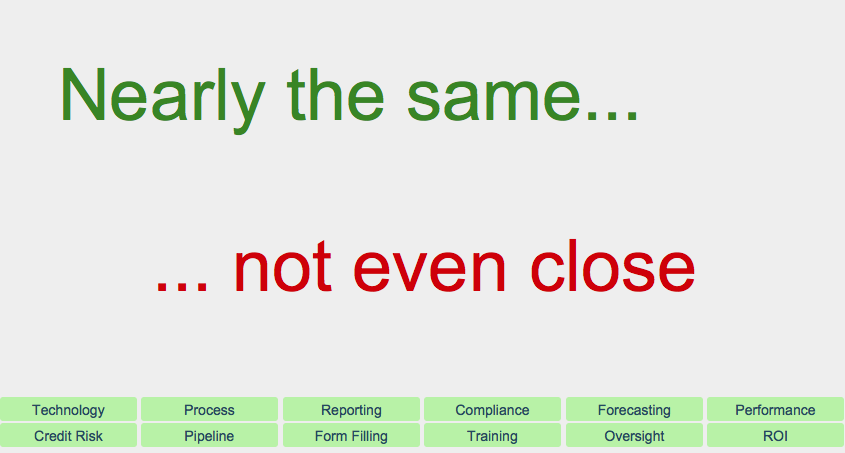
I had written a system for a client and they are now creating a new business that is nearly the same as the current one. Each businesses needs to fill a large hole with waste material, delivered to site by truck.
Same task: Fill the hole.
We met and discussed the idea at some length and there were clearly similarities. It seemed so very close.
However my task is to create a system that is optimal for the particular business the system is going to be used for.
In the first case there were hundreds of clients per year in the second 10. In the first case the business needed to manage 2-3 truck journeys per client within a few days. In the second there would be hundreds per client over several months.
In the first, the nature of the material was varied but getting it right was critical to meeting compliance. In the second the size of the clients and the size of each job were so large that compliance was as good as guaranteed.
The question was – could we re-use the current system for the second business and tweak it a bit?
We could have – but in doing so we would miss out on all the wonderful benefits of custom databases.
Here are some of the differences:
System A – Many clients/few trucks
- Where there are many clients there is a benefit to creating an online section to the system to allow the client to enter key data themselves – this saves a lot of time collecting data and ensures that the person who knows the data best (the client), enters it. The system can also ensure that the client is not able to return a half completed form and can guide them through the process of filling it out cutting down on errors dramatically. First time right.
- Since we are uncertain of what is being delivered we can stop the truck at the entry to the site and take photos of the registration plate and the contents of the truck and link this back to the delivery note. We now have a visual record of what was actually delivered when and by whom.
- The trucks are all run by the client – what was unknown was the nature of the material being delivered. This meant that we could train the drivers, as we knew who they were, and we could reduce the amount of on-screen hand-holding required.
- From a management viewpoint we were less interested in the client and more interested in the efficiency of the drivers. How many loads were they delivering per day, what was their workload like over the coming weeks, when were trucks due to be maintained- what more work could we pursue?
- In this case we would have many clients – each with a lower value. We would not have time to credit check each client. But some might order more that one job. We needed to be able to learn from their prior payment record.
System B – Few Clients/Many trucks
- Where there are many truck journeys being carried out there is a likelihood that the same drivers arrive on site over and over again. This means that we can put a simple system on site that allows the drivers to sign in when they arrive and complete the notification of delivery. The weighbridge could automatically fill in the weight delivered and produce a printout for the driver. The driver can then be instructed on where to deliver the waste material with an on screen map and the same map can appear on the printed delivery confirmation. This removed the need for any paperwork and resulted in instant feedback to head office and fewer drivers out on site.
- In this case we had little interest in the driver’s performance – they were not our drivers. What we were interested in was the remaining work to be carried out for each client, how many trucks had arrived on site during the last week and therefore how many were likely to arrive during the coming week, we could then predict when the work for the client would be completed. We could also asses how busy the site was going to be over the coming months and when we needed to start scheduling in the 11th and 12th client.
- In this case we had the potential of a single client running 10 trucks to site each day and even with weekly invoicing, the 30 day payment terms meant that if a client was late paying the impact and credit risk could be significant. We needed more controls over payments and a way of stopping new deliveries if the credit limit was being exceeded or likely to be exceeded.
- The client would want a complete record of what deliveries were made to site and we could attach this to the emailed invoice – including the drivers signature.
- The accounts department had little to check as all the data had effectively been pre-verified – they would just need to trigger the invoice process and within seconds emails, with the invoices attached, would be sent out to each client.
These were just some of the considerations, and as they kept accumulating, the decision was taken to create a new bespoke system for the second business. The cost saving to the client would be in the tens of thousands per year.
